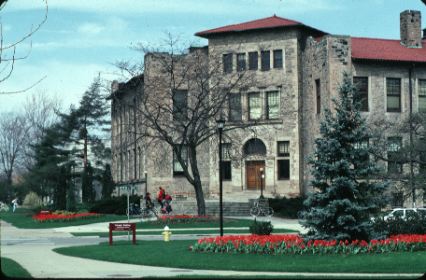Severance Laboratory(Now Severance Hall) 120 West Lorain, 1899-1901 |

The modernization of scientific training at Oberlin accelerated in 1901. That fall Professor Frank Jewett led his chemistry students, each with an armload of apparatus, in a jubilant march from the cramped rooms of old Cabinet Hall (which stood in decay just south of Peters Hall) to the new Severance Laboratory. Jewett recalled it as a trip from captivity to the promised land. He had spent a sabbatical year examining the latest facilities at universities at home and abroad, and worked closely with young Chicago architect Howard Van Doren Shaw in planning Severance. Money for the new building came from trustee Louis Henry Severance, treasurer of the Standard Oil Company, whose son had studied chemistry under Jewet.
Shaw was just beginning a distinguished career in architecture. He took pride in the exacting craftsmanship and fine detail of his work. His design fitted the tight dimensions of the site and anchored the northwest corner of Tappan Square with a crisp and pleasing sandstone facade. Midway through construction Jewett discovered that some of the interior walls were being lined with overbaked brick. Alarmed, he mailed one of the offending bricks to Shaw, who wired back, "Stop work until I arrive." Shaw came from Chicago by the next train, inspected the scene, and order the defective lining rebuilt from scratch. Those were the days.
By the late 1950s the attitudes of Oberlin's chemists toward Severance began to echo Jewett's feelings about Cabinet Hall. In 1962 they moved into the new Kettering Hall next door, and Severance was refitted for geology and psychology. The momentum of scientific technology makes it unlikely that the mesh between Severance and its users will ever be as satisfying as it once was for Jewett and his students.
(Blodgett 10-11)
For information about Severance within the context of Oberlin College architecture, please click here.